Weekends at the Museum
(Note: All workshops are conducted in Italian)
Educational workshops are offered on Saturdays and the second Sunday of each month to the general public. The workshops are held in the same laboratory halls as the school group workshops and are carried out in a similar manner, but adapted to the different age ranges of the participants. The approach is more playful and the experience offered can vary considerably based on different needs of the public. The activities are aimed towards a wide public, with particular attention to families.
Days: from September to May, on rotation with the school group workshops, Saturday afternoon and the second Sunday of every month;
in the month of June, Saturday morning and the evening of the last Thursday of the month.
Target: eight years and up
Duration: 60 minutes
For reservations and information:
Museo dei Ragazzi di Firenze
tel. 055 2768224 | fax 055 2768558 | E-mail info.museoragazzi@comune.fi.it
Daily from 9:00 AM to 7:00 PM
Art and Science: the Science of Drawing
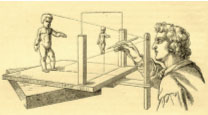 The invention of perspective in the beginning of the 1400s represents an extraordinary event both for the arts and for mathematical sciences. For nearly 500 years perpective has played a central role in the interests, often common, of artists and mathematicians. In this interactive laboratory visitors are introduced to the science of drawing, namely the set of techniques and theoretical concepts which constitute the basis of Renaissance perspective, using shadow projections in order precisely understand the rules of perspective. The invention of perspective in the beginning of the 1400s represents an extraordinary event both for the arts and for mathematical sciences. For nearly 500 years perpective has played a central role in the interests, often common, of artists and mathematicians. In this interactive laboratory visitors are introduced to the science of drawing, namely the set of techniques and theoretical concepts which constitute the basis of Renaissance perspective, using shadow projections in order precisely understand the rules of perspective.
Microscopy from the 1600s to the 1800s
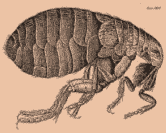 (Associazione Museo dei Ragazzi for the IMSS) (Associazione Museo dei Ragazzi for the IMSS)
A fascinating voyage through the world of the infinitely small, the confines of which were discussed for the first time at the beginning of the 17th century, when Galileo made his first occhialino. With the aid of modern reflection microscopes, endowed with a large ocular lens that allows for viewing by more than one person at the same time, some stages in the exploration of the microscopic world will be illustrated, from observation of single-cell organisms to microscopic anatomy, from histology (study of animal and plant tissues) to the study of pathogenic germs.
Philosophers and Meteors
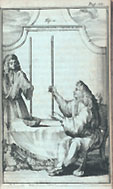 Three and a half centuries ago, under Medicean patronage a meteorological network was instituted, with stations throughout various European countries for constant and homogenous monitoring of the temperature. The academics of the Cimento - the first scientific society in Europe, founded in 1657 by Prince Leopoldo and the Grandduke of Tuscany Ferdinando II de' Medici - dedicated, furthermore, a lot of attention to atmospheric phenomena and to the perfection of meteorological instruments, contributing to the affirmation of modern meteorology. To witness this important phase and illustrate how much modern meteorology is indebted to the first measurements performed with instruments of the era, a virtual meteorological station has been prepared which uses reconstructions of antique instruments. Three and a half centuries ago, under Medicean patronage a meteorological network was instituted, with stations throughout various European countries for constant and homogenous monitoring of the temperature. The academics of the Cimento - the first scientific society in Europe, founded in 1657 by Prince Leopoldo and the Grandduke of Tuscany Ferdinando II de' Medici - dedicated, furthermore, a lot of attention to atmospheric phenomena and to the perfection of meteorological instruments, contributing to the affirmation of modern meteorology. To witness this important phase and illustrate how much modern meteorology is indebted to the first measurements performed with instruments of the era, a virtual meteorological station has been prepared which uses reconstructions of antique instruments.
Measuring Heaven and Earth
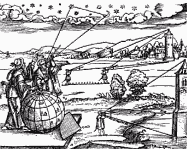 In the modern age the use of instruments for measuring elements of the heavens and the Earth. The first surveying instruments were the astrolabe, the quadrant, the "balestriglia" (also called a cross-staff or "Jacob's staff") and the Praetorian table. To these were added other instruments which allowed for making topographical calculations, such as Latin radii, geometric or gnomonic squares, compasses, plumb lines, levels, shadow rules, squares…these measuring instruments had different applications. They may have been used by navigators for calculating position, by geographers for tracing maps, by topographers for describing a territory on a map, by architects and engineers for calculating heights and dimensions of buildings, by scenographers for laying out the scenes that were played out in the background of parties and in the theatrical performances that were held in court. Workshop participants will be able to act as architects, topographers and geographers and take measurements with replicas of the principal instruments. In the modern age the use of instruments for measuring elements of the heavens and the Earth. The first surveying instruments were the astrolabe, the quadrant, the "balestriglia" (also called a cross-staff or "Jacob's staff") and the Praetorian table. To these were added other instruments which allowed for making topographical calculations, such as Latin radii, geometric or gnomonic squares, compasses, plumb lines, levels, shadow rules, squares…these measuring instruments had different applications. They may have been used by navigators for calculating position, by geographers for tracing maps, by topographers for describing a territory on a map, by architects and engineers for calculating heights and dimensions of buildings, by scenographers for laying out the scenes that were played out in the background of parties and in the theatrical performances that were held in court. Workshop participants will be able to act as architects, topographers and geographers and take measurements with replicas of the principal instruments.
The Messenger of the Stars
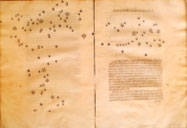 (Associazione Museo dei Ragazzi for the IMSS) (Associazione Museo dei Ragazzi for the IMSS)
Galileo is universally known because in 1609 he put together the telescope with which he carried out the observations that brought him to revolutionary astronomical discoveries, which constituted the first experimental confirmation of the heliocentric theory proposed, seventy years before, by Nicolaus Copernicus. In this laboratory the same Galileo retraces his principal observations: from the discovery of the valleys of the Moon to the fact that the Milky Way is not a denser part of the heavens but rather a striking mass of stars, from the discovery of the four satellites of Jupiter to the strange appearance of Saturn, to the phases of Venus and sun spots.
.................................
(All workshops are conducted in Italian)
|